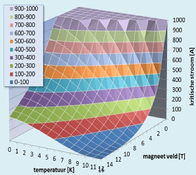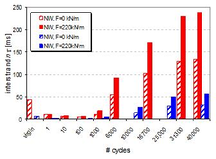AC LOSS, INTERSTRAND RESISTANCE AND TRANSVERSE STIFFNESS OF FULL SIZE ITER SUPERCONDUCTORS UNDER CYCLIC LOADING


Research financially supported by the ITER Organisation. ![]()
The cabled superconductors to be applied in ITER have to withstand enormous electromagnetic forces and fast ramping magnet fields. Important research on this subject is done at the EMS group for more than a decade. The effort led to discovery of the remarkable change in AC loss with cyclic loading, inevitable knowledge for fusion magnets.
Creating reliable and economic operating superconducting magnets needs basic understanding of materials science, its fundamental phenomena and a multi-physics approach. Facing the great challenge of the complex interaction of all individual aspects, e.g. current and potential distribution, lattice strain, thermal instabilities, material diffusion and interaction that can occur in composite cabled superconductors, asks for an integrated multidisciplinary approach. One of the key ingredients is the Twente Cryogenic Cable Press, developed to study AC loss, interstrand resistance and cable deformation under ITER relevant loading conditions in terms of temperature, applied magnet field alteration, force and number of load cycles. Besides delivering important new scientific results, the facility also serves for qualification tests of ITER conductors and the Press AC loss results are the exclusive basis for AC loss analysis and stability of the entire ITER magnet system.
ITER Magnets and conductors
The impressive and unprecedented ITER Magnet System comprises 18 superconducting Toroidal Field (TF) and 6 Poloidal Field (PF) coils, a Central Solenoid (CS), and a set of Correction coils (CC) that magnetically confine, shape and control the plasma inside the Vacuum Vessel. The power of the magnetic fields required to confine the plasma in the ITER Vacuum Vessel is extreme. For maximum efficiency and to limit energy consumption, ITER uses superconducting magnets that lose their resistance when cooled down to very low temperatures. The TF and PF coils lie between the Vacuum Vessel and the Cryostat, where they are cooled (at 4 K) and shielded from the heat generating neutrons of the fusion reaction taking place at a temperature of 150 million K (see illustration below). The TF coils will weigh 6540 tons total and the strands have a total length of 80,000 kilometers; besides the Vacuum Vessel, they are the biggest components of the ITER machine. The superconducting magnets (CS and TF) are designed to achieve operation at high magnetic field (13 Tesla) and large current (up to about 70 kA). The superconductors are special alloys made of Niobium and Tin (Nb3Sn). The PF and the CC coils use a different, Niobium-Titanium (NbTi) alloy.
The coils will be made of Cable-In-Conduit superconductors, in which a bundle of superconducting strands is cabled together and cooled by flowing Helium, and contained in a structural steel jacket (see photo below).


The ITER fusion reactor with superconducting coils and plasma (left), a full-size ITER superconductor from the Central Solenoid Magnets with almost 1000 superconducting and copper strands of 0.8 mm diameter (middle) and the twisted structure of the cable elements (right).
Characteristics of ITER superconductors
The open nature of the cable bundles in the sizeable Cable-In-Conduit-Conductors for ITER containing more than thousand strands, have a void fraction of around 30 % to be filled with helium, which is needed for sufficient cooling capacity preserving stable behavior.
The maximum values of temperature, electrical current and magnetic field are interdependent and the pictures below show the critical surface for a superconductor, which is the boundary between superconductivity and normal resistivity in 3 dimensional space. The applied field (B), the temperature (T) and the current density (J) must be maintained below the critical surface in order to retain superconductivity (see plots below). In other words, if the operating temperature is about 5 K and the transition at 7 K, the margin left is 2 K.


The critical surface for a superconductor, which is the boundary between superconductivity and normal resistivity in 3 dimensional space, applied field (B), temperature (T) and current density (J).
When conditions in a localized region of a superconductor exceed the critical surface, that area will start to conduct resistively producing local heating. The resulting heat and current transfer will start a cascade effect and result in a rapid transition of the whole superconductor to the normal state (quenching).
The electromagnetic AC loss of ITER Nb3Sn and NbTi CICCs, related to changing magnetic field depending on the plasma scenario, is in this manner crucial for their stability as it leads to a higher temperature of the conductor. The overall lifetime characteristics in terms of AC loss, interstrand contact resistance, cable compression, changes in transverse stiffness and mechanical losses are experimentally evaluated on various NbTi and Nb3Sn conductors in the Twente Press. This is particularly critical for application in fusion reactors like ITER, because the number of load cycles can be up to 60,000.
Presently the unique test site is also used for ITER conductor qualification testing. The large cables are subjected to the magnet operation conditions with huge mechanical forces, transient magnet field and cryogenic temperatures (4.2 K) proving mainly their quality in terms of AC loss and thus sufficient temperature margin. The AC loss data are essential for the thermal analysis of the entire ITER magnet system as these results are the only adequate data available for the ITER magnet system.

The unique Twente Cryogenic Cable Press for simulation of the ITER magnet operating conditions up to 70,000 A in 12 T background magnet field (left).


On top the results of the mechanical characterization and below the drastic increase of the AC loss (and heating by power dissipation) with the number of load cycles in the ITER Poloidal Field Conductor.
Sustainable energy
Nuclear fusion is seen as one of the answers to the worldwide energy issues: it is clean, safe and sustainable and does only produce short-living radioactive waste. The energy is generated from melting together light and heavy atomic nuclei, within a plasma at extremely high temperature. Nuclear fusion is the energy source of the sun and the stars. Compared to fossil fuels, this source of energy is inexhaustible. Superconducting magnets will be almost one third of the building costs of the ITER Tokamak, to be built in Cadarache in France; this experimental reactor aims at delivering 500 Megawatt by nuclear fusion. November 2006, the participating countries have signed the contracts for building this reactor. Parallel to this, the G8 countries have placed nuclear fusion high on their agendas as a sustainable way of generating energy.
For more information, please contact Arend Nijhuis: ![]()
![]()
Links: ITER ![]()
Papers on this subject
- A. Nijhuis, H.H.J. ten Kate, and P. Bruzzone, ‘The Influence of Lorentz Force on the AC Loss in Sub-size Cable-In-Conduit Conductors for ITER’, IEEE Transactions on Applied Superconductivity, Vol. 7, No. 2, June 1997, 262-265
- A. Nijhuis, Niels H.W. Noordman, H.H.J. ten Kate, Neil Mitchell and Pierluigi Bruzzone. ‘Magnetic and Mechanical AC Loss of the ITER CS1 Model Coil Conductor under Transverse Cyclic Loading’, Physica C, ISSN : 0921-4534, Vol/Iss. : 310 / 1-4, 1998, pp.: 253-257
- A. Nijhuis, N.H.W. Noordman, H.H.J. ten Kate, N. Mitchell and P. Bruzzone, ‘Electromagnetic and Mechanical Characterisation of ITER CS-MC Conductors Affected by Transverse Cyclic Loading, Part 1: Coupling Current Loss’, IEEE Transactions on Superconductivity, Vol. 9, no.: 2, June 1999, pp. 1069-1072
- A. Nijhuis, N.H.W. Noordman, H.H.J. ten Kate, N. Mitchell and P. Bruzzone, ‘Electromagnetic and Mechanical Characterisation of ITER CS-MC Conductors Affected by Transverse Cyclic Loading, Part 2: Interstrand Contact Resistances,’ IEEE Transactions on Superconductivity, Vol. 9, no.: 2, June 1999, pp. 754-757
- A. Nijhuis, N.H.W. Noordman, O.A. Shevchenko, H.H.J. ten Kate, and N. Mitchell, ‘Electromagnetic and Mechanical Characterisation of ITER CS-MC Conductors Affected by Transverse Cyclic Loading, Part 3: Mechanical Properties,’ IEEE Transactions on Superconductivity, Vol. 9, no.: 2, June 1999, pp. 165-168
- A. Nijhuis, N.H.W. Noordman, N. Mitchell, H.H.J. ten Kate, ‘Electromagnetic and Mechanical AC loss of an ITER TF Model Coil Conductor (DP4) under Transverse Cyclic Loading’, IEEE Transactions on Superconductivity, Vol. 10, no.: 1, March 2000, pp. 588-591, ISSN 1051-8223
- A. Nijhuis, Y. Ilyin, W. Abbas, and H.H.J. ten Kate, ‘Evolution of contact resistance and coupling loss of ITER PF prototype conductors under transverse load’, IEEE Transactions on Applied Superconductivity, Vol. 13, no.: 2, June 2003, pp. 2388-2391, ISSN 1051-8223
- A. Nijhuis, Y. Ilyin, W. Abbas, B. ten Haken and H.H.J. ten Kate, ‘Change of Interstrand Contact Resistance and Coupling Loss in Various Prototype ITER NbTi Conductors with Transverse Loading in the Twente Cryogenic Cable Press up to 40,000 Cycles’, Cryogenics, Volume 44, Issue 5, May 2004, pp. 319-339
- W. Abbas, A. Nijhuis, Y. Ilyin, B. ten Haken and H.H.J. ten Kate, ‘A Fully Automatic Press for Mechanical and Electrical Testing of Full Size ITER Conductors under Transverse Cyclic Load’, Advances in Cryogenic Engineering, Materials, Vol. 50, pp. 51-58, 2004
- Y. Ilyin, A. Nijhuis, W. Abbas, and H.H.J. ten Kate, ‘Electromagnetic Performance of Sub-size NbTi CICC’s Subjected to Transverse Cyclic Loading’, IEEE Trans. Appl. Supercond., Vol. 14, No. 2, (2004), pp. 1503-1506
- A. Nijhuis, Y. Ilyin, W. Abbas, B. ten Haken and H.H.J. ten Kate ‘Performance of an ITER CS1 Model Coil Conductor under Transverse Cyclic Loading up to 40,000 cycles’, IEEE Trans. Appl. Supercond., Vol. 14, No. 2, (2004), pp. 1489-1494
- A. Nijhuis, Y.A. Ilyin, W. Abbas, H.H.J. ten Kate, M.V. Ricci and A. della Corte, ‘Impact of void fraction on mechanical properties and the evolution of coupling loss in ITER Nb3Sn conductors under cyclic transverse loading’, IEEE Trans. Appl. Supercond. Vol 15, No. 2, June 2005, 1633-1636
- Y. Ilyin, A. Nijhuis, W. Abbas, P. Bruzzone, B. Stepanov, P. Gislon, L. Muzzi, L. Zani, ‘Effect of Cyclic Loading and Conductor Layout on Contact Resistance of Full-Size ITER PFCI Conductors’, IEEE Trans. Appl. Supercond., Vol 15, No. 2, June 2005, 1359-1362
- A. Nijhuis and Y. Ilyin, ‘Transverse Load Optimisation in Nb3Sn CICC Design; Influence of Cabling, Void Fraction and Strand Stiffness’, Supercond. Sci. Technol. 19 (2006) 945-962. IOP Select: articles chosen by our Editors for their novelty, significance and potential impact on future research. IOP Select reflects both the breadth and international significance of papers published in our prestigious peer reviewed journals
- A. Nijhuis, Y. Ilyin, ‘Transverse cable stiffness and mechanical losses associated with load cycles in ITER Nb3Sn and NbTi CICCs’, Supercond. Sci. Technol. 22 (2009) (13 pp.) 055007
- Miyoshi, Y., Ilyin, Y., Abbas, W., Nijhuis, A., ” AC loss, inter-strand resistance, and mechanical properties of an option-II ITER CICC up to 30,000 cycles in the press” IEEE Trans App Supercond 21 (2011), art. no. 5617311, pp. 1944-1947
